present phylogeographically resolved data for 2043 M269-derived Y-chromosomes from 118 West Asian and European populations assessed for the M412 SNP that largely separates the majority of Central and West European R1b lineages from those observed in Eastern Europe, the Circum-Uralic region, the Near East, the Caucasus and Pakistan. Within the M412 dichotomy, the major S116 sub-clade shows a frequency peak in the upper Danube basin and Paris area with declining frequency toward Italy, Iberia, Southern France and British Isles.The supplementary data contains more detailed information on the frequency and diversity of R1b subclades in various population samples. Dienekes comments.
The dating (and consequently the authors' specific attempts to link the spread of R1b to archaeological horizons) is likely badly off; the various subclades are probably much younger than calculated by the authors. It's also far from clear to me that R1b entered Europe via Anatolia (as opposed to a more northerly route). Either way, the Iberian Irish myth is still very dead.
I haven't read the Cruciani paper (pdf).
References:
Myres et al. A major Y-chromosome haplogroup R1b Holocene era founder effect in Central and Western Europe. European Journal of Human Genetics doi: 10.1038/ejhg.2010.146
Cruciani et al. Strong intra- and inter-continental differentiation revealed by Y chromosome SNPs M269, U106 and U152. Forensic Science International: Genetics doi:10.1016/j.fsigen.2010.07.006






